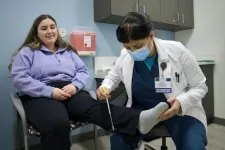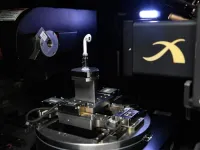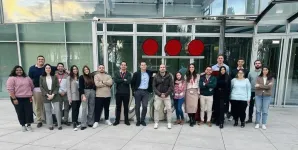(Press-News.org) Biochar: bridging a gap in carbon removal strategies
As the world works to meet net-zero carbon goals, a new study offers a critical reminder: precision matters. The researchers suggest refining how we assess a natural carbon storage strategy to ensure the technology lives up to its potential as a climate change solution.
Biochar, a charcoal-like material derived from plant biomass, has long been hailed as a promising tool for carbon dioxide removal. However, a new study by Stanford researchers highlights a critical issue: current methods for assessing biochar's carbon storage potential may significantly undervalue its true environmental benefits. The paper, published in Environmental Research Letters points the way to more accurately evaluating biochar, and boosting its credibility as a climate change solution.
The research, supported by the Stanford Woods Institute for the Environment’s Environmental Ventures Program and Stanford’s Sustainability Accelerator, challenges conventional durability metrics and proposes a more nuanced framework for evaluating biochar projects. It grew out of an early project looking at soil’s ability to capture carbon dioxide.
“We realized that even though biochar is really important component of the carbon removals market, there is very little useful data on how it actually behaves,” said study coauthor Kate Maher, a professor of Earth system science in the Stanford Doerr School of Sustainability and a senior fellow at the Stanford Woods Institute for the Environment. “It is important for policymakers and buyers to be aware of this.”
Rethinking biochar durability
Biochar is the charcoal-like result of burning organic matter slowly with little oxygen. Its appeal lies in its ability to store carbon in soil for extended periods, preventing it from re-entering the atmosphere as a greenhouse gas. The durability of biochar—its resistance to decomposition—is a key factor in determining its effectiveness.
However, most biochar durability assessments rely on a single metric: the hydrogen-to-carbon ratio. This simple measure is thought to correlate with biochar’s stability in soil, but the Stanford study reveals that this approach might be too reductive. By reanalyzing the largest existing biochar durability dataset, the researchers uncovered that relying solely on hydrogen-to-carbon ratios ignores critical factors such as soil type, environmental conditions, and biochar feedstock variability. Without these factors, models often fail to predict real-world outcomes for carbon storage and benefits to soil health and crops.
“Biochar has immense potential for carbon dioxide removal, but it will be viewed as less valuable by the market until we can confidently establish and predict its long-term durability,” said study coauthor A.J. Ringsby, a chemical engineering Ph.D. student in the Stanford School of Engineering. “To get to a place where biochar stacks up against highly durable solutions like direct air capture, we need to move beyond one-size-fits-all metrics and do the ground work to develop more useful datasets.”
The study also found that current standards may underestimate the carbon storage potential of many biochar projects. Laboratory experiments, often the basis for durability assessments, are more tractable but often fail to accurately replicate real-world conditions. For instance, field studies show that factors like soil composition and local climate can drastically influence how biochar behaves once deployed.
Undervaluing biochar’s durability potentially leaves a substantial amount of carbon storage uncredited. This could create economic and policy challenges, especially as the demand for carbon offsets grows.
Towards a smarter future
To address these shortcomings, the researchers propose a two-step evaluation process: a preliminary estimate of biochar’s potential to remove carbon dioxide before deployment, followed by field measurements to refine these estimates over time. This approach, they argue, could unlock additional project value, improve data for predictive modeling, and enhance the credibility of biochar in carbon markets.
The study also underscores the need for coordinated global field trials to better understand how environmental variables influence biochar performance. These trials could inform new durability standards that account for real-world variability, paving the way for more accurate carbon crediting.
“Unlike most technologies in the market, biochar is shovel-ready and delivering carbon removal today,” Ringsby said. “To unlock its full potential, we need better data, stronger standards, and to work together as a community to design the right experiments.”
The study was also funded by the National Science Foundation.
Accelerating greenhouse gas removal
The researchers’ work to improve biochar durability assessments comes as part of an effort by the Sustainability Accelerator to enable removal of billions of tons of greenhouse gases annually from Earth’s atmosphere by mid-century. Learn more about how the Accelerator is speeding translation of Stanford research into technology and policy solutions to sustainability challenges.
END
Bridging a gap in carbon removal strategies
2025-02-04
ELSE PRESS RELEASES FROM THIS DATE:
Outside-in signaling shows a route into cancer cells
2025-02-04
A new study shows how an anticancer drug triggers an “outside in” signal that gets it sucked into a cancer cell. The work, published Jan. 29 in Nature Communications, reveals a new signaling mechanism that could be exploited for delivering other drugs.
Many malignant cancers overexpress a protein called P-cadherin, which is embedded in the cell membrane. Because cancer cells have a lot of P-cadherin sticking out of their surface, the protein has been targeted for drug development.
Monoclonal antibodies against P-cadherin can carry a drug payload to the cancer cells. It has not been clear, though, exactly how the antibodies attach to P-cadherin ...
NFL wives bring signature safe swim event to New Orleans
2025-02-04
NEW ORLEANS, Feb. 4, 2025 — The American Heart Association, a global force changing the future of health, is promoting water safety, a multi-market priority initiative for the Off the Field National Football League Wives Association. The American Heart Association provided Hands-Only cardiopulmonary resuscitation (CPR) and automated external defibrillator (AED) education as part of the safe swim event held at Tulane University’s Reily Center on Tuesday, Feb. 4. The event welcomed nearly ...
Pickleball program boosts health and wellness for cancer survivors, Moffitt study finds
2025-02-04
TAMPA, Fla. (Feb. 4, 2025) — A new community-based pickleball program called Project Rally is helping cancer survivors improve their physical and social well-being, according to a recent pilot study led by researchers at Moffitt Cancer Center. The program, which is offered in partnership with the YMCA of the Suncoast, has shown strong results in terms of participation, enjoyment, and physical improvements.
Staying active is a key part of cancer survivorship care and research. Physical activity can help reduce the negative effects of cancer and its treatments, while also empowering survivors to live fulfilling lives. It offers many ...
International Alzheimer’s prevention trial in young adults begins
2025-02-04
The first participants in an international clinical trial aimed at preventing Alzheimer’s disease in young adults at high risk of the disease have been enrolled. The trial, led by Washington University School of Medicine in St. Louis, aims to determine whether stopping the early molecular changes that lead to symptomatic Alzheimer’s disease can prevent the disease from ever taking hold. The study is enrolling people as young as 18 who have few or no detectable Alzheimer’s-related molecular changes in their brains, up to 25 years before the expected onset ...
Why your headphone battery doesn't last
2025-02-04
Ever notice that batteries in electronics don't last as long as they did when they were brand new?
An international research team led by The University of Texas at Austin took on this well-known battery challenge, called degradation, with a twist. They're focusing their work on real-world technology that many of us use daily: wireless earbuds. They deployed x-ray, infrared, and other imaging technologies to understand the complexities of all the technology packed in these tiny devices and learn why their battery lives erode over time.
"This started with my personal headphones; I only wear the right one, and I found ...
Study probes how to predict complications from preeclampsia
2025-02-04
The existing prediction models for severe complications of preeclampsia are most accurate only in the two days after hospital admission, with deteriorating performance over time, according to a new study published February 4th in the open-access journal PLOS Medicine by Henk Groen of University of Groningen, the Netherlands, and colleagues.
Preeclampsia is a potentially life-threatening condition that can occur during pregnancy; of women diagnosed with preeclampsia, 5-20% will develop severe complications. Two existing PIERS (Pre-eclampsia Integrated ...
CNIC scientists design an effective treatment strategy to prevent heart injury caused by a class of anticancer drugs
2025-02-04
A team of scientists at the Centro Nacional de Investigaciones Cardiovasculares (CNIC), working in collaboration with international partners, has designed a strategy for preventing the cardiotoxic effects of anthracyclines, a widely used class of anticancer drugs. Cardiotoxicity is a frequent adverse secondary effect of cancer therapy with these drugs. The study, published in JACC: CardioOncology, demonstrates that treatment with the SGLT2 inhibitor empagliflozin can mitigate the cardiac injury associated with anthracycline therapy.
Anthracyclines are first-line medications in the treatment of cancer, but in 5% of patients their use is associated ...
NYU’s Yann LeCun a winner of the 2025 Queen Elizabeth Prize for Engineering
2025-02-04
New York University’s Yann LeCun has been selected as a winner of the 2025 Queen Elizabeth Prize for Engineering—one of seven recognized for contributions to the advancement of Modern Machine Learning, which has fueled advances in artificial intelligence.
“This year, we celebrate the remarkable achievements that these seven engineers have contributed to Modern Machine Learning, a field that has revolutionized artificial intelligence by uniting algorithms, hardware, and data,” said Lord Vallance, chair of the Queen Elizabeth Prize for Engineering Foundation. “The impact of this innovation is felt across industries, economies, and the planet, ...
New study assesses impact of agricultural research investments on biodiversity, land use
2025-02-04
New study assesses impact of agricultural research investments on biodiversity and land use
Data analysis spans 1960s Green Revolution to 2015
WEST LAFAYETTE, Ind. — New, groundbreaking research shows how, at a local scale, agricultural research and development led to improved crop varieties that resulted in global benefits to the environment and food system sustainability. The Purdue University study appears in the latest issue of Proceedings of the National Academy of Sciences.
“At the global level, we see a reduction in cropland use from these technology ...
High-precision NEID spectrograph helps confirm first Gaia astrometric planet discovery
2025-02-04
NEID (rhymes with fluid) is a high-precision radial-velocity spectrograph that is designed to measure the extremely minute wobble of nearby stars using the radial velocity effect. This effect results from the mutual gravitational force between a planet and its host star which causes the star’s position to shift very slightly as the planet travels around it. With this powerful capability, one of NEID’s main science goals is to confirm exoplanet candidates found by other exoplanet missions.
NEID is funded by the NASA/NSF Exoplanet Exploration Program (NN-EXPLORE) and is mounted on the WIYN 3.5-meter Telescope at ...





